|
Throughout this site we use many technical terms, and given the breadth of readership our site enjoys, sometimes we are remiss and incorrectly assume everyone knows what we are referring to. For those that do not, here are some explanations of the technical terms use. |
 |
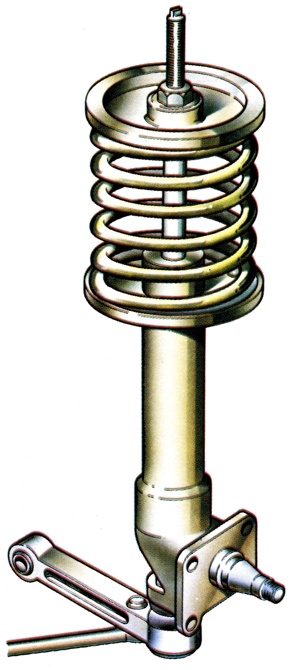
A long telescopic tube, containing the damper and running inside the coil spring, that is attached at its top end to the upper section of a car's wheel arch and rigidly connected to the stub axle at the lower end. A single transverse link controls the tracking, being bushed to the car's structure at the inner end and connected to the stub axle at the other by a ball joint. Fore and aft stiffness between the two units on an axle is maintained by inter-connecting them with a stabilizer bar attached to the lower links. |
 |
This term originally referred to a wheel cast in magnesium or a magnesium alloy, but now is a more loosely defined term that refers to any cast wheel. |
 |
A very light metal, easily combustible, used in alloy form for road wheels and other components on some specialized cars and engines. It has a good strength to weight ratio and is easily machined. |
 |
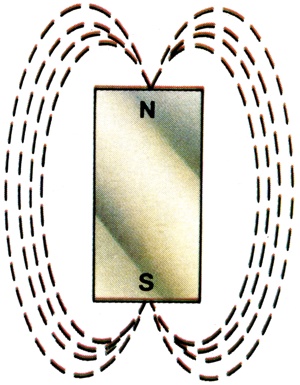
The region around a magnet or electrical conductor in which a magnetic influence is detected, the extent depending on the power of the magnet. |
 |
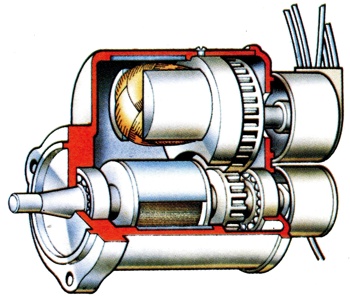
A device, fitted to most cars up to 1930 and still used on some motor cycles, to provide the necessary high-tension (HT) current to ignite an engineer's air-fuel mixture. It includes a dynamo, with the armature rotated by the engine, an induction coil, a rotating contact breaker and, on multi-cylinder engines, a distributor. |
 |
The bearings supporting the crankshaft, at its main journals, in the crankcase. Although older, smaller engines of four cylinders were frequently designed with only two main bearings, additional main bearings are found on modern engines at crankcase webs and, depending on the number of cylinders, total from three to seven. They may be thick or thin-walled types and are split. Roller bearings or ball races have sometimes been used at the end journals. |
 |
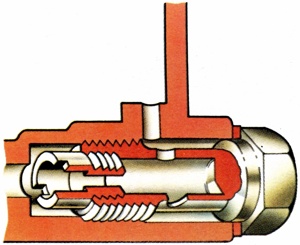
The uncompensated jet of a multi-jet design of fixed-choke carburettor, on the simpler versions the only jet save that for slow running. In the latter case some provision is made to prevent the mixture naturally getting richer with increasing engine speed and, in the former, a separate compensating system and jet is used to achieve this requirement. |
 |
An improved form of cast iron having higher tensile strength and less brittleness, produced by lengthy heating of the castings in haematite (iron oxide) to reduce some of the carbon content. |
 |
A metal used in some alloy steels to increase toughness and give marked work-hardening characteristics; it is found particularly in cylinder liners or where a hard-wearing surface is required. |
 |
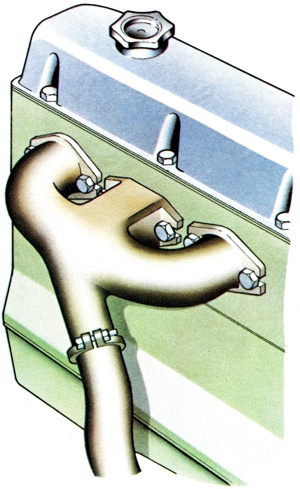
Usually a casting, but sometimes a fabricated trunking, connecting the exhaust or inlet passages from the cylinders to a common opening, to which the exhaust pipe, or carburettor, is attached. On earlier vehicles particularly, the manifold sometimes served both exhaust and inlet requirements. Commonly referred to as the grouping of pipes that distribute the inlet charge from the carburettor to the various cylinders and likewise the exhaust gases from the various cylinders to the exhaust system. |
 |
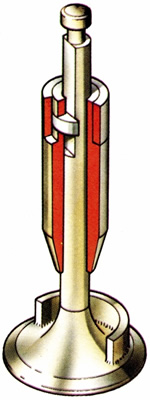
A poppet-type valve having the addition of a shroud or mask for part of the circumference under the valve head; to ensure correct location of this mask in the inlet port, the valve stem has a flat section to line up with the key in the valve guide. The object of this design is to direct the incoming gas into a rotation of the bore and so increase turbulence to enhance thorough combustion of the air/gas mixture. |
 |
The amount of matter in a body; when acted upon by gravity the mass becomes the body's weight. |
 |
The production of large quantities of identical or similar items by a repetitive process in industry. |
 |
Any item which repeatedly reverses direction, i.e. reciprocates, such as pistons, con-rods, pushrods, valves and rockers. As such items are constantly being accelerated and decelerated, forces are involved which entail mechanical losses and lead to overall inefficiency. Thus, to achieve better acceleration and top speeds from an engine, direct-acting overhead camshafts, rather than pushrods and rockers, are favoured. |
 |
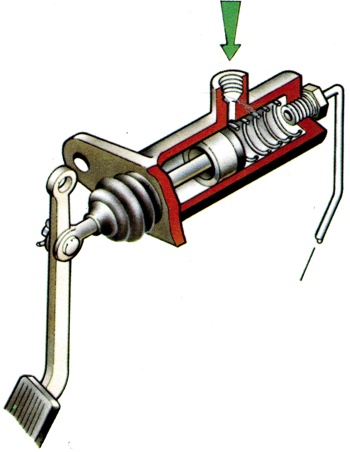
The component in the hydraulic brake system which converts pedal force (or pedal plus servo force) into hydraulic pressure. Essentially it is a closed cylinder with suitable ports and contains a leak-proof piston which is moved by application of the pedal, thereby displacing hydraulic fluid. |
 |
A type of anti-wheelspin device used on some (GM) Buick cars. It employs a solid state computer which causes repeated instantaneous interruption of the ignition systems if the rear wheel speed exceeds that of the front wheels by 10 per cent or more, thus thought to ensure maximum effective traction.
|
 |
A die-casting zinc alloy containing small amounts of aluminium, copper and magnesium and used extensively in the motor industry for carburettor bodies, door handles, boot and bonnet hinges, wing mirror arms and decorative door trim. Such items usually are chromium plated but, if neglected, suffer from inter-crystalline corrosion. |
 |
The ignition timing point at which maximum mean effective pressure is produced in the cylinder for most efficient engine operation. Automatic advance-retard mechanisms are designed to achieve this timing irrespective of speed and load. |
 |
The product of twice an engine's stroke and rpm. As the piston speed rises, so does the inertia of the reciprocating parts and the maximum mean piston speed of a modern car engine is approximately 915 metres/min (3,000ft/min). |
 |
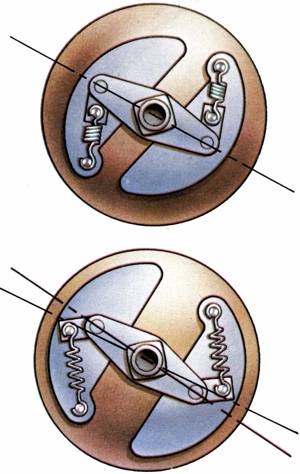
That part of the automatic advance and retard mechanism of a modern petrol engine which responds only to variations in engine speed (not load). Centrifugal force acting on twin rotating weights overcomes the force of return springs and advances the position of the cam and rotor relative to the driveshaft as engine speed increases, thus advancing the ignition progressively. |
 |
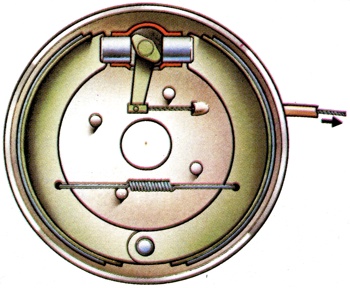
Brakes, usually of the internal expanding shoe type, operated by rods or cables, levers, and cams or wedge units, with suitable compensators for balanced effect between the wheels. On modern cars they are usually used only for handbrake actuation. |
 |
Basically this is the ratio of output work to input work on any machine but for engine performance considerations it is taken as the ratio of Brake power to Indicated power (bmep to imep) and varies with speed and load. |
 |
This is the conversion factor that permits heat energy to be converted, theoretically, to the mechanical energy it should produce if it were 100 per cent efficient. Thus, one British Thermal Unit (BTU) is equivalent to 107kg/m (7781b/ft) of mechanical work. |
 |
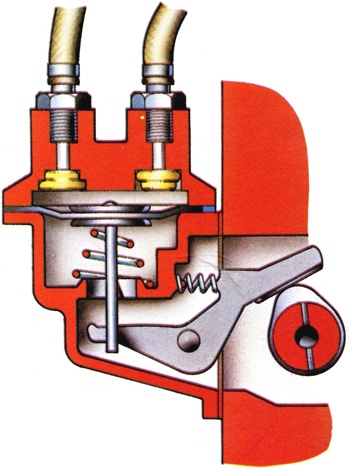
A diaphragm-type pump with inlet and outlet non-return valves, the operating arm being actuated from the engine camshaft. The pump raises petrol from the fuel tank to supply the carburettor float-chamber. |
 |
A specially-developed cast iron that is alloyed with, for example, nickel, copper, chromium and molybdenum and is suitably heat-treated to produce, cheaply, such highly-stressed components as camshafts and crankshafts.
|
 |
A precision gauge, based on the dial indicator, used for measuring cylinder bores for ovality and wear. |
 |
A design of car in which the engine is located immediately in front of the rear axle and behind the driver. |
 |
Due to the leakage from pressure-fed bearings and from the turbulence and splashing set up by rotating and reciprocating parts, the interior of the crankcase of an engine running at normal temperature is filled with an oil mist which gives sufficient lubrication for parts not supplied with oil under pressure, or splash, such as the small end bearings on many designs. |
 |
The ratio of air to fuel. The chemically correct mixture strength for petrol is usually 14 or 15 to 1, depending on the blend, and thus the chemical composition of the petrol, but other combustible fuels used alone, or in a blend, may have quite a different ratio. Alcohols, for example, have a ratio of 7 or 8 to 1. Mixtures having less air than the chemically correct ratio are rich; those with more air are weak. Weaker mixtures are sometimes used for economical cruising under low power conditions. |
 |
A full-scale model of a prototype car made in wood or clay, usually painted and decorated with i all trim, for aesthetic and practical analysis before the final decision to produce it is taken. |
 |
An alloying material added to carbon steel during the production process. At high temperatures it gives extra hardness and enhances the toughness during the tempering operation. Examples are chromium-molybdenum and nickel-chromium-molybdenum. |
 |
An oil additive that reduces friction between surfaces and, by giving them a protective coating, minimizes the chances of a seizure occurring, even for some time after the oil supply has ceased. |
 |
The turning effect of a force acting on a body some distance from its pivot or fulcrum. It is the product of the force and its perpendicular distance from the fulcrum. |
 |
A sequence of brake tests on an engine to achieve a reasonable assessment of Indicated Power at given speeds and throttle openings where equipment is not available to produce an IMEP from an indicator diagram or trace. The engine is tested first with all cylinders operating and then with each cylinder cut-out in turn. The indicated power can be calculated as the sum of the resultant losses. |
 |
A form used to shape components during the production operation. In a foundry, molten metal is poured into a mould that is contoured to exactly reproduce the required shape of the casting. Moulds are also used to shape tyres and glass-fibre panels and may be either male or female (convex or concave) in their shape. |
 |
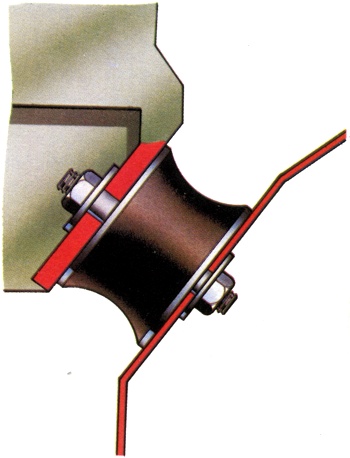
The means of attachment of major items such as the engine and gearbox, suspension units or sub-frames, to the chassis or main frame. To eliminate vibration and noise, mountings usually incorporate rubber cushioning bonded to the metal brackets. |
 |
Imperial system of measuring fuel consumption. Now replaced by litres per 100 kilometres. |
 |
An expression used to describe engines with more than one cylinder. Increasing the number of cylinders is a more effective method of raising an engine's cubic capacity than increasing the bore as a better power to weight ratio results and the unit's inherent balance is superior. |
 |
Engine lubricating oils which, by dint of additives, are less affected in viscosity by changes in temperature, are called Multigrade oils. They are designated by dual viscosity numbers, such as 10W/40, signifying that the viscosity at �18�C (�1�F) is comparable to that of a "strength" oil of SAE 10, and at 99 C (211�F) is comparable to a "strength" oil of SAE 40 grading. |
|
|
Sell Your Car or Parts
Browse the Classifieds
It's Absolutely Free! - Find Out More
|



